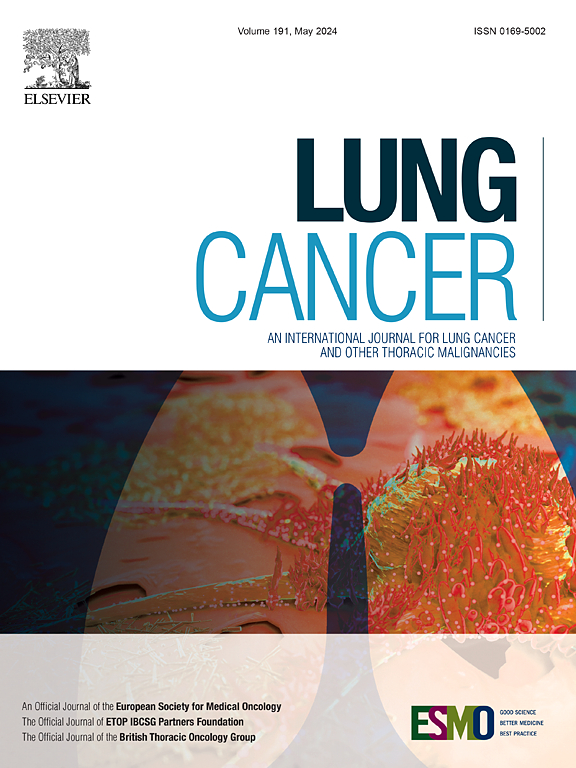基线无脑转移的非小细胞肺癌患者在一线(化疗)免疫治疗期间发生脑转移的临床危险因素
IF 4.4
2区 医学
Q1 ONCOLOGY
引用次数: 0
摘要
脑转移(BM)在非小细胞肺癌(NSCLC)中很常见。尽管指南推荐在无症状患者中进行基线BM筛查,但其益处仍未得到证实。常规成像给医疗系统和患者带来负担。免疫检查点抑制剂(ICI)显示相似的颅内和颅外应答百分比,支持局部脑转移治疗的延迟和可能的筛查。然而,解离反应发生。因此,在一线ICI期间新诊断为BM的患者可能从基线(和随访)筛查中获益最多。在一线以ci为基础的治疗中识别脑转移进展或发展的高危患者对于优化筛查至关重要。方法回顾性多中心队列研究,2018-2021年间接受一线(化疗)ICI治疗的基线BM未知的IV期非小细胞肺癌患者。分析新诊断BM的发生率、时间和症状负担。Cox回归确定了预测因素,并建立了nomogram。结果在589例患者中,9.0%的患者在治疗期间被诊断为BM, 88.7%的患者在治疗一年内被诊断为BM。大多数病例(90.6%)有症状。四个因素预测更高的BM风险:年龄<; 65岁(HR 2.66; 95% CI: 1.49-4.74), T4期(HR 2.08; 95% CI: 1.18-3.65), M1c期(HR 2.19; 95% CI: 1.22-3.94)和PD-L1 <; 50% (HR 2.03; 95% CI: 1.16-3.54)。nomogram显示了良好的性能(C-index 0.70)。12个月累计发病率为11.7% (95% CI: 8.5 - 14.9%)。结论在基线BM未知的IV期NSCLC患者中,一线(化疗)ICI中BM检出率相对较低,但负担(症状)较高。经验证,确定的危险因素可以支持高危患者的选择性脑成像,避免对低危患者进行常规筛查。本文章由计算机程序翻译,如有差异,请以英文原文为准。
Clinical risk factors for developing brain metastases during first-line (chemo-)immunotherapy in patients with non-small cell lung cancer without known baseline brain metastases
Background
Brain metastases (BM) are common in non-small cell lung cancer (NSCLC). Although guidelines recommend baseline BM screening in asymptomatic patients, its benefit remains unproven. Routine imaging burdens healthcare systems and patients. Immune checkpoint inhibitors (ICI) show similar intra-and extracranial response percentages, supporting deferral of local BM treatment and possibly screening. However, dissociated responses occur. Therefore, patients newly diagnosed with BM during first-line ICI probably would have benefited most from baseline (and follow-up) screening. Identifying high-risk patients for BM progression or development during first-line ICI-based therapy is crucial to optimize screening.
Methods
Retrospective multicenter cohort study of patients with stage IV NSCLC without known baseline BM, treated with first-line (chemo-)ICI between 2018–2021. Incidence, timing, and symptom burden of newly diagnosed BM were analyzed. Cox regression identified predictive factors, and a nomogram was developed.
Results
Among 589 patients, BM were diagnosed during therapy in 9.0 %, 88.7 % occurred within the first year. Most cases (90.6 %) were symptomatic. Four factors predicted higher BM risk: age < 65 years (HR 2.66; 95 % CI: 1.49–4.74), T4 stage (HR 2.08; 95 % CI: 1.18–3.65), M1c stage (HR 2.19; 95 % CI: 1.22–3.94) and PD-L1 < 50 % (HR 2.03; 95 % CI: 1.16–3.54). The nomogram showed good performance (C-index 0.70). Twelve-month cumulative incidence was 11.7 % (95 % CI: 8.5–14.9 %).
Conclusion
BM detection during first-line (chemo-)ICI is relatively low in patients with stage IV NSCLC without known baseline BM, but the burden (symptoms) is high. Upon validation, the identified risk factors may support selective brain imaging in high-risk patients, avoiding routine screening in low-risk patients.
求助全文
通过发布文献求助,成功后即可免费获取论文全文。
去求助
来源期刊

Lung Cancer
医学-呼吸系统
CiteScore
9.40
自引率
3.80%
发文量
407
审稿时长
25 days
期刊介绍:
Lung Cancer is an international publication covering the clinical, translational and basic science of malignancies of the lung and chest region.Original research articles, early reports, review articles, editorials and correspondence covering the prevention, epidemiology and etiology, basic biology, pathology, clinical assessment, surgery, chemotherapy, radiotherapy, combined treatment modalities, other treatment modalities and outcomes of lung cancer are welcome.
 求助内容:
求助内容: 应助结果提醒方式:
应助结果提醒方式:


